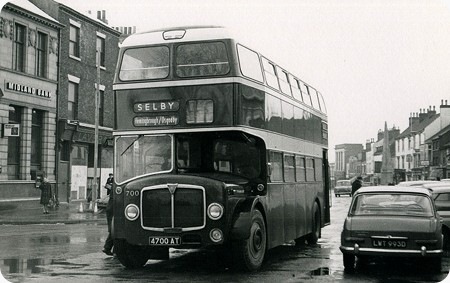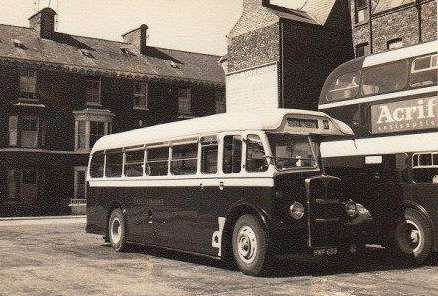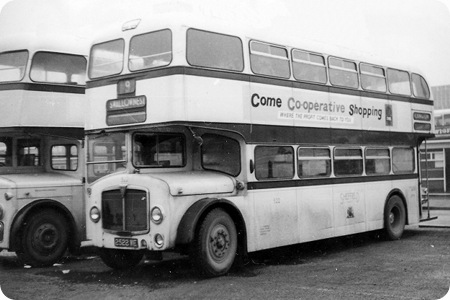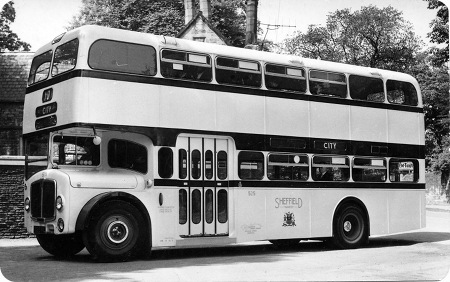
Photograph by ‘unknown’ if you took this photo please go to the copyright page.
Sheffield Corporation
1961
AEC Bridgemaster
Park Royal H43/29F
I think this photo was taken when this bus was new it looks in very good condition to me. The angle of the shot does show up the very square and upright look of the Park Royal Bridgemaster. Why did the Bridgemaster have that small window to the left of the entrance doors (see D Oldfield update below) no other front entrance bus that I know of did. There must be a reason apart from just having a window otherwise moving the doors more into the saloon would be wasted space, bodybuilders do not waste space. If you know, let me know, please leave a comment.
“Reg no 1925 WA fleet no 525 was one of six Bridgmasters supplied to Sheffield Transport the other five were all rear entrance. It has been preserved.
George
“I think there was a first batch of six, all rear entrance followed 2 years later by a one off front entrance.
Anonymous
I have a shot of a rear entrance Sheffield Bridgemaster so I will do more research and it will arrive shortly with full details.
In fact I have done the research and the bus arrived on Monday 3rd August, here is a link to it.
Peter
Sheffield Bridgemasters: 519-524 were rear entrance with a row of five rear facing seats, Lodekka style, at the front of the saloon. This covered the gearbox/differential housing – which can be seen at the front of the saloon of all traditional half-cabs. On Bridgemasters, this was extra large – hence the reason on the front entrance version for the doors to be set further back and the strange small window.
From a Sheffielder who travelled – at times – on all seven vehicles.
David Oldfield
This photo would have been taken by the corporations own photographer. It is taken outside the gates of Norfolk Park. The council took photos of all there new buses here. The East Bank, Shoreham Street and Queens Road depots were all less than a mile from here.
James Walker
06/07/12 – 07:20
This bus was often to be seen on the number 7 route to Stannington
Brian
03/10/13 – 08:49
I have conducted on 525 doing a few weddings this summer. Can any of your Sheffield experts tell me why the lower deck has a green interior including seats whilst the staircase and upper deck is red.
Geoff S
03/10/13 – 14:35
Because that was the standard post war interior colour scheme until 1959. Only in 1960, with 1325-1349, did the inside saloons begin to have a red scheme, but not all. This scheme only lasted until 1966 when the interiors were again changed – this time to blue on each deck. Why? I have to admit, I often wondered that myself but – as we were often told in the days, it is because it is!
David Oldfield
03/10/13 – 15:41
David, I remember the wheels being blue for a while too, due to local politics, but don’t think that would be the reason for the seats as the council was very red at the time.
Les Dickinson
04/10/13 – 06:11
True or not, Les, it’s the sort of childish behaviour we’ve come to expect from modern-day politicians! Some years, ago, when Big Ben was being renovated, it was found that the original paint applied to the clockfaces was blue. In the interests of historical accuracy, preparations were made to repaint them blue, until the non-Labour MP’s got to hear of it. They remained black! Of course, compromise could have made three of them red, blue and yellow respectively, with the other one…… pink!
Chris Hebbron
04/10/13 – 15:14
On the interiors, we have to remember the down stair seats were upholstered, whilst the upstairs were leather, so smokers would not damage them.
My personal choice was for red wheels with chrome rings, even though I come from the blue half of the city.
Andy Fisher
04/10/13 – 17:21
Blue half, Andy? That much?
David Oldfield
05/10/13 – 15:38
More like the blue 3/4 side.
Andy Fisher
22/10/13 – 17:37
Just thought I would let you know that the first vehicle in the fleet to have blue seats (moquette on both decks incidentally) was No 340, the Commercial Motor Show Atlantean exhibit of 1964. It was also the first to sport blue wheels. The Fleetline’s which came the same year had the normal red seats and wheels etc as did the Neepsend bodied Atlantean’s. It was 1966 that the blue seats and wheels were adopted as standard, the first vehicles being Park Royal and Neepsend bodied Atlantean’s and the Bedford VAS/Craven.
Trev Weckert
23/10/13 – 17:41

It was never going to be as attractive as Kylie M’s rear aspect but interesting nevertheless. Seen here before final touches added after repaint.
John Darwent
24/10/13 – 07:50
I always think that this PRV design was the ugliest they ever came up with and one of the ugliest ever by anyone. It first graced Atlanteans then PD2s, Regent Vs and Tiger (PS1/PS2) rebuilds. Nevertheless, every time I see 525 I feel a great affection for it. Are the proportions better than on the East Kent Regent Vs? Does the livery suit it better? …..or am I just a big softie who remembers the old girl when she was brand new, doing the Herdings in Sheffield? […..and that is a fantastic photo, John.] I’d love to have a drive of her.
David Oldfield
26/10/13 – 07:22
I seem to remember seeing the rear open platform buses, at the bus stop on Olive Grove Road on the 101 Arbourthorne route. Service 28 & 43 also run from that stop. Rightly or wrongly I believed that they had some kind of air suspension that you could bounce up & down. Would this be so? My times catching the 43, they had Regent 5s with front operated doors, a handsome bus, but I never rode a Bridgemaster.
Andy Fisher
26/10/13 – 12:15
64-73 were, indeed, handsome buses. 1963 Regent V 2D2RA with Weymann Aurora bodywork. They were regular performers on the 28/43 group. [My Grandmother lived on the 28 route.] You are right about the air suspension on the Bridgemasters.
David Oldfield
29/10/13 – 07:38
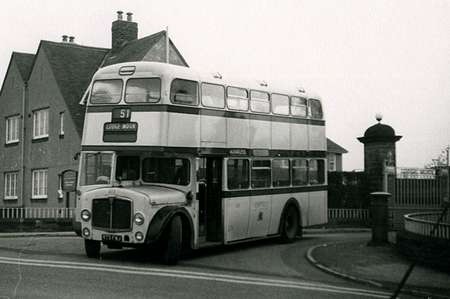
Here is 273 (originally 73) as mentioned by David above it is seen reversing at Lodge Moor Hospital on 20th January 1968.
Ian Wild
29/10/13 – 13:16
Thanks for that, Ian. I always thought that these were the best looking front loader AECs. 435-460 (1960s back loader Orions) were also handsome buses. A great pity that Sheffield never had front loader Roe bodies on their Regent Vs as the Park Royals were "unbalanced" and not at all attractive. Give me 64-73 any time.
David Oldfield
29/10/13 – 13:18
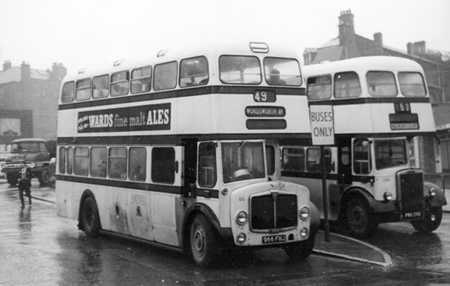
Here is an off side view of 66 (966 FWJ). What a day that was didn’t stop raining all day.
Peter
29/10/13 – 16:11
Totally agree, a handsome bus & the ones I remember. These were one of the first busses I remember that had the string pull bell, asking the passenger to stop the bus with one pull. There may have been other types, just that I did not ride them. I also think they had 2 door opening levers, one for the driver in the cab & one for the conductor on the bulkhead, or was there room for the driver to operate the bulkhead one. Of the Atlanteans of the era, I preferred the Park Royal bodywork.
There was a coach building firm on Penistone Road, on the right hand side just before the speedway track outbound. I think they made the 1965 c reg, on the Shiregreen route, may have been 47 & 48 routes. Their terminus was on Bridge Street. They had twin windows at the rear & also the upstairs emergency window & not a particularly good looking thing. Does anyone have any photos or information on the coach builder or pictures? I have pictures of them as part of streets scenes, but no information, as the subject matter was on how things looked at the time.
Andy Fisher
30/10/13 – 07:07
They were the Neepsend bodied PDR1/2 Atlanteans built between 1964 and 1966. There is still a misconception about Neepsend Coachworks. Cravens of Darnall came out of bus building after the 1950 Regent IIIs for Sheffield. At the suggestion of East Lancs own board of directors they came back in 1964 by buying all the shares of East Lancashire Coachbuilders from their three owner/directors. Cravens decided to create more capacity by building a new factory at Neepsend, Sheffield but to use East Lancs designs. Initially this was done by building up East Lancs parts but eventually everything was built in Sheffield for Neepsend bodies. This didn’t last for long and extra capacity was unnecessary – so Neepsend production had ceased by 1968. [Neepsend quality was apparently not up to Lancashire standards either.] East Lancs continued in Cravens ownership until Cravens themselves were bought by John Brown and the Trafalgar House. Eventually ownership passed to Drawlane – but Neepsend was long gone by this time.
David Oldfield
30/10/13 – 07:07
Penistone Road- That would be Neepsend (which is where they were) who suddenly appeared there in the 60’s- until ? They were part of East Lancs and possibly there was an incentive to open up there. The factory had see-through doors and bus skeletons would slowly appear for passers by and then be clad.
Joe
30/10/13 – 07:08
Andy, Neepsend Coachworks was on Penistone Road as you describe. Neepsend was a subsidiary of East Lancs Coachbuilders, Blackburn. They built two batches of bodies of 20 each on Leyland Atlantean PDR1/2 chassis for Sheffield in 1964/5/6. I thought they were good looking buses, better than the Park Royals as they had equal depth windows on each deck. Neepsend fitted new staircases to Sheffield Weymann bodied Regents 811 and 813 at a time when Queens Road was overwhelmed by such work on the batch of 40.
Ian Wild
30/10/13 – 11:52
Ian, Neepsend was not a subsidiary of East Lancs. This is one of the long standing misconceptions of bus industry history. The correct story is given above in great detail by David.
Roger Cox
31/10/13 – 07:11
David, thanks for the clarification over Neepsend ownership. Huddersfield had 16 CVG6LX delivered in 1966, half bodied by East Lancs and half by Neepsend. The bodies from each source were randomly distributed amongst the fleet numbers. I don’t recall either make of body being any worse than the other when it came to the first COF at 7 years
Ian Wild
31/10/13 – 08:16
That’s OK, Ian, there have been years of obfuscation over the ownership but, even as a kid in Sheffield when they were built, I was aware that they were "really" Cravens. East Lancs, being the higher profile name, people would, and did, jump to the wrong conclusion. To be strictly correct, both East Lancs AND Neepsend were independent subsidiaries of the holding company Cravens. [The details came from the East Lancs book from Venture (or was it TPC?).] It was common to mix and match East Lancs and Neepsend in an order – I think it happened at Southampton – which I think is bizarre, but I wasn’t running the company. Somehow, I’d missed out that Huddersfield had any – only took 57 years for me catch up!
David Oldfield
31/10/13 – 15:07
I think a great deal of the confusion comes from the fact that traditional East Lancs customers placed orders with that company and, because of either lack of space at the Blackburn factory or to give work to Neepsend, orders or part orders were dealt with by Neepsend. It would be interesting to know how much say the customer had in where the vehicle was bodied. I know that in the case of Stockport its 1967 order was split because the chassis, already delayed due to a large order book at Leyland, would have lingered for many months, or been bodied by another company, had half the order not been dealt with by Neepsend. The two batches were at least numbered one following from the other but it was widely understood over the ensuing years in service that the Sheffield product was inferior.
Phil Blinkhorn
02/11/13 – 17:57
I borrowed a book from the library on Firth Browns steel company. One of the separate companies, (from poor memory Firths) bought Cravens, as a way of placing their steel. It said they made railway carriages, trams & busses. It must have been early 1900s, because there was not a lot of bus activity, although expanding fast, but lots of the other forms of public transport. The next time I use the library, (I will have to be quick as Sheffield is closing numerous libraries, politics, do not get me started) I will get the book out again to research, unless you chaps know the answer.
Andy Fisher
07/11/13 – 15:25
Got the book now. John Brown of Firth Browns (world renown steel company here in Sheffield), bought Cravens in 1919. It was called at that time Cravens Train & Carriage Company or something similar. I am not sure if Sheffield had any busses in 1919, as trams ruled. He bought it when work was short in the steel industry. It enabled him to sell wheels, axles & springs to them.
Andy Fisher
07/11/13 – 17:55
Just returning to the point about East Lancs orders being fulfilled at Neepsend, it seems all the frames were supplied from East Lancs thus enhancing the widely held view of the relationship between the companies that had Neepsend as the junior partner.
Phil Blinkhorn
08/11/13 – 06:39
Phil. I would probably still call them the junior partner, they simply weren’t owned by, nor were they a subsidiary of, East Lancs. Both were owned by Cravens – but in terms of volume and life-span Neepsend was certainly the baby brother, dependent on its older sibling.
David Oldfield
08/11/13 – 06:39
There is of course an interesting thread on a Neepsend posting under the Bodybuilder section of the OBP site. Coincidentally, the final post is by one John Brown!
John Darwent
24/11/13 – 07:38
I have got another book which proves my presumption of no buses in 1920. It shows a Daimler, double decker, solid wheels, with Allen (Sheffield) bodywork, around 1912. Any more info from you gentlemen?
Andy Fisher
26/11/13 – 15:42
In my last posting I should have said my presumption of no buses pre 1920 was wrong. Sheffield Corporation took over the running of busses a few days after WW1 broke out, around the 7th of August 1914.
Did any other Corporations in other city’s do the same?
Andy Fisher
01/12/13 – 08:19
Lovely to see my favourite bus from my schoolboy days in the early Sixties is still alive and kicking! Driving down Wortley Road in Rotherham I could not believe my eyes when there she was parked waiting to pick up a wedding party! Who now owns her and where does she live? (the link at the top of his thread did not work when I tried it) I would love to visit her for old time sake and relive schoolboy memories.
I became acquainted with her and her six rear loading sisters on the 101,102 & 105 routes to Gleadless Townend/Herdings in 1962. I always wondered why the Bridgemasters were used on these routes, there being no overbridges on these routes. I never saw them on any other route but previous threads show they were.
The attraction about 525 to me was the lovely turbine like whining noise she made in top gear. this was not shared with her sisters, can anyone explain why. Does she still sound the same given she has been re-engined. You could always tell AECs because if the whining noise they made in lower gears but this top gear noise appeared to be unique to 525.
I had heard stories that she had been preserved but it was lovely to see her out and about again. What happened to her and her sisters after they left Sheffield and why was she the only one?
Andrew T
You are correct Andrew the link goes nowhere, I have deleted it. Thanks for that.
01/12/13 – 08:48
1925 WA is believed to be privately owned by a member of the Blackman family, and is sometimes used on wedding and other hires by the same family’s Halifax-based Yorkshire Heritage Buses.
John Stringer
02/12/13 – 13:32
John
Try the following website, www.yorkshireheritagebus.co.uk
Its the Yorkshire Heritage Bus Company based at Luddenden Foot between Sowerby Bridge and Hebden Bridge in the Calder Valley.
Their website shows 525 as part of their collection.
It appears to be minus its fleet number and Sheffield coat of arms on its sides.
Andrew T
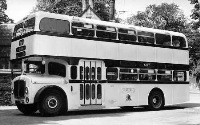 Vehicle reminder shot for this posting
Vehicle reminder shot for this posting
26/02/17 – 07:09
I was placed on Sheffield 525 as a trainee conductor for about a week on the Herding’s route during the long, bad winter ( ice, more than snow )of 1963 ; very glad of the doors! She was a splendid beast all round I thought. Some years later, when driving, I never got a chance on her, but once volunteered, after duty, to drive 519 back from the centre to East Bank garage just to have a go on a Bridgemaster.
Sheffield, in those days, had transfers in the cab reading ‘Do not rest your foot on the clutch pedal’, and the way out-dated ‘ You are driving a covered top bus’ ! Overtime was referred to as ‘Suet’ for some strange reason.
All in all, Sheffield had a superbly well maintained and turned-out fleet, with staff always correctly attired. I later moved to Manchester Transport at Hyde Road garage and was shocked by both the road staff’s bad attitude and their disregard for full uniform dress. The culture shock also included finding that conductors there were known as ‘Guards’, not forgetting new words like ‘Demic’, meaning something, e.g. a bus, having broken down " It’s a demic."
One ‘guard’ I worked with there knew of the incident years before when a Sheffield single deck bus had crashed into, and brought down, part of the Manchester Victoria Railway Station facade. He said, The only good thing to come from Sheffield is the road to Manchester’. The fact that it is also used in reverse seemed not to have registered!
Of interest is that the Neepsend coachwork’s building on Penistone Road was still being completed after production had begun there when a new wall collapsed crushing some part-built bus bodies. That must have been in 1962 ?
I have some interesting correspondence from the late GM, Geoffrey Hilditch, whom I once met, regarding solving issues with Manchester’s trolleybuses and also the many problems adapting the former London Feltham trams to the Leeds system, but I don’t understand this site yet, so not sure where it should go.
Mike C
